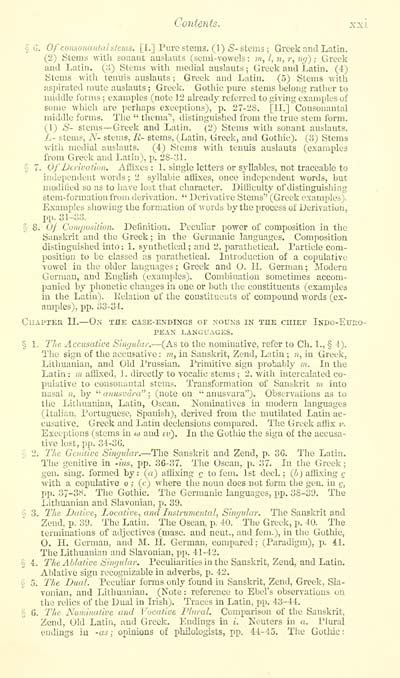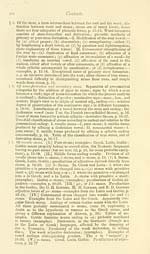Blair Collection > Celtic studies
(25)
Download files
Complete book:
Individual page:
Thumbnail gallery: Grid view | List view

Contents. xxi
, w. Ofconsonankd stems, [I.] Pure stems. (1) 5- stems ; Greek and Latin.
(2) Stems witli sonant ausLiuts (semi-vowels: vi, I,n,r,n</) ; Greek
and Latin. (.J) Stems with medial auslauts ; Greek and Latin. (4)
Stems with tenuis auslauts ; Greek and Latin. (5) Stems with
aspirated nmte auslauts ; Greek. Gothic pure stems belong rather to
middle forn\s ; examples (note 12 jdready referred to tiiving examples of
some which are perliaps exceptions), p. 27-28. [11.] Consonantal
middle forms. The " thcma'', distinguished from the true stem form.
{\) S- stems— Greek and Latin. (2) Stems with sonant auslauts.
L- stems, N- stems, R- stems, (Latin, Greek, and Gothic). (8) Stems
M-itli medial auslauts. (4) Stems with tenuis auslauts (examples
from Greek and Latin), p. 28-31.
§ 7. Of Dtr'wation. Affixes : 1. single letters or syllables, not traceable to
independent words ; 2 syllabic atJixes, once independent words, but
moditied so as to have lost that ch.aracter. Dilhculty of distinguishing
stem-formation from derivation. " Derivative Stems'' (Greek examples).
Examples showing the formation of words by the process of Derivutiou,
pp. 31-33.
§ 8. Of Coiuposidon. Definition. Peculiar power of composition in the
Sanski-it and the Greek; In the Germanic languages. Composition
distinguished into : 1. synthetical ; and 2. parathetical. Particle com-
position to be classed as parathetical. Introduction of a copulative
vowel in the older languages; Greek and U. II. German; Modern
German, and English (examples). Combination sometimes accom-
lianied by phonetic changes in one or botii llie constituents (exami)les
in the Latin). Kelation of the coustituouts of compound words (ex-
amples), pp. 33-34.
CuAi'TER 11. — On the case-endings of nouns in tue chief Indo-Eueo-
TEAN l.ANGLIAGES.
§ 1. The Accusative Singular. — (As to the nominative, refer to Ch. L, § 4),
The sign of the accusative : m, in Sanskrit, Zend, L:itin ; n, in Greek,
Lithuanian, and Old Prussian. Primitive sign probably m. In the
Latin : m affixed, 1. directly to vocalic stems ; 2. with intercalated co-
pulative to consonantal stems. Transformation of Sanskrit m into
nasal n, by " cmusvara" ; (note on " anusvara"). Observations as to
the Litlmanian, Latin, Oscan. Nominatives in modern languages
(italir.n, Portuguese, Spanish), derived from the mutilated Latin ac-
cusative. Greek and Latin declensions comi)ared. The Greek affix v.
Exceptions (stems in tj and iv). In the Gothic the sign of the accusa-
tive lost, pp. 34-36.
§ 2. The Geiiiiive Singular.— The Sanskrit and Zend, p. 3G. The Latin.
The genitive in -ius, pp. 36-37. The Oscan, p. 37. In the Greek;
gen. sing, formed by: (a) affixing c to fem. 1st deck; (ii) affixing j
with a copulative o ; (c) where the noun does not form the gen. in g,
pp. 37-3H. The Gothic. The Germanic languages, pp. 38-39. The
Lithuanian and Slavonian, p. 39.
5 3. 2'he Dative, Locative, and Instrumental, Singular. The Sanskrit and
Zend, p. 39. The Latin. The Oscan, p. 40. The Greek, p. 40. The
terminations of adjectives (masc. and neut., and fem.), in the Gothic,
O. H. German, and M. II. German, compared; (Paradigm), p. 41.
The Lithuanian and Slavonian, pp. 41-42.
§ 4. The Ablative Singular. Peculiarities in the Sanskrit, Zend, and Latin.
Ablative sign recognizable in adverbs, p. 42.
5. 'The Dual. PecuUar forms only found in Sanskrit, Zend, Greek, Sla-
vonian, and Lithuanian. (Note : reference to Ebel's observations on
the relics of the Dual in Irish). Traces in Latin, pp. 43-44.
§ G. The Nominative and Vocative Plural. Comparison of tlie Sanskrit,
Zend, Old Latin, and Greek. Endiugs in i. Neuters in a. Plund
endings iu -as; opinions of philologists, pp. 44-45. The Gothic:
, w. Ofconsonankd stems, [I.] Pure stems. (1) 5- stems ; Greek and Latin.
(2) Stems witli sonant ausLiuts (semi-vowels: vi, I,n,r,n</) ; Greek
and Latin. (.J) Stems with medial auslauts ; Greek and Latin. (4)
Stems with tenuis auslauts ; Greek and Latin. (5) Stems with
aspirated nmte auslauts ; Greek. Gothic pure stems belong rather to
middle forn\s ; examples (note 12 jdready referred to tiiving examples of
some which are perliaps exceptions), p. 27-28. [11.] Consonantal
middle forms. The " thcma'', distinguished from the true stem form.
{\) S- stems— Greek and Latin. (2) Stems with sonant auslauts.
L- stems, N- stems, R- stems, (Latin, Greek, and Gothic). (8) Stems
M-itli medial auslauts. (4) Stems with tenuis auslauts (examples
from Greek and Latin), p. 28-31.
§ 7. Of Dtr'wation. Affixes : 1. single letters or syllables, not traceable to
independent words ; 2 syllabic atJixes, once independent words, but
moditied so as to have lost that ch.aracter. Dilhculty of distinguishing
stem-formation from derivation. " Derivative Stems'' (Greek examples).
Examples showing the formation of words by the process of Derivutiou,
pp. 31-33.
§ 8. Of Coiuposidon. Definition. Peculiar power of composition in the
Sanski-it and the Greek; In the Germanic languages. Composition
distinguished into : 1. synthetical ; and 2. parathetical. Particle com-
position to be classed as parathetical. Introduction of a copulative
vowel in the older languages; Greek and U. II. German; Modern
German, and English (examples). Combination sometimes accom-
lianied by phonetic changes in one or botii llie constituents (exami)les
in the Latin). Kelation of the coustituouts of compound words (ex-
amples), pp. 33-34.
CuAi'TER 11. — On the case-endings of nouns in tue chief Indo-Eueo-
TEAN l.ANGLIAGES.
§ 1. The Accusative Singular. — (As to the nominative, refer to Ch. L, § 4),
The sign of the accusative : m, in Sanskrit, Zend, L:itin ; n, in Greek,
Lithuanian, and Old Prussian. Primitive sign probably m. In the
Latin : m affixed, 1. directly to vocalic stems ; 2. with intercalated co-
pulative to consonantal stems. Transformation of Sanskrit m into
nasal n, by " cmusvara" ; (note on " anusvara"). Observations as to
the Litlmanian, Latin, Oscan. Nominatives in modern languages
(italir.n, Portuguese, Spanish), derived from the mutilated Latin ac-
cusative. Greek and Latin declensions comi)ared. The Greek affix v.
Exceptions (stems in tj and iv). In the Gothic the sign of the accusa-
tive lost, pp. 34-36.
§ 2. The Geiiiiive Singular.— The Sanskrit and Zend, p. 3G. The Latin.
The genitive in -ius, pp. 36-37. The Oscan, p. 37. In the Greek;
gen. sing, formed by: (a) affixing c to fem. 1st deck; (ii) affixing j
with a copulative o ; (c) where the noun does not form the gen. in g,
pp. 37-3H. The Gothic. The Germanic languages, pp. 38-39. The
Lithuanian and Slavonian, p. 39.
5 3. 2'he Dative, Locative, and Instrumental, Singular. The Sanskrit and
Zend, p. 39. The Latin. The Oscan, p. 40. The Greek, p. 40. The
terminations of adjectives (masc. and neut., and fem.), in the Gothic,
O. H. German, and M. II. German, compared; (Paradigm), p. 41.
The Lithuanian and Slavonian, pp. 41-42.
§ 4. The Ablative Singular. Peculiarities in the Sanskrit, Zend, and Latin.
Ablative sign recognizable in adverbs, p. 42.
5. 'The Dual. PecuUar forms only found in Sanskrit, Zend, Greek, Sla-
vonian, and Lithuanian. (Note : reference to Ebel's observations on
the relics of the Dual in Irish). Traces in Latin, pp. 43-44.
§ G. The Nominative and Vocative Plural. Comparison of tlie Sanskrit,
Zend, Old Latin, and Greek. Endiugs in i. Neuters in a. Plund
endings iu -as; opinions of philologists, pp. 44-45. The Gothic:
Set display mode to: Large image | Transcription
Images and transcriptions on this page, including medium image downloads, may be used under the Creative Commons Attribution 4.0 International Licence unless otherwise stated. ![]()
| Early Gaelic Book Collections > Blair Collection > Celtic studies > (25) |
|---|
| Permanent URL | https://digital.nls.uk/75771457 |
|---|
| Description | A selection of books from a collection of more than 500 titles, mostly on religious and literary topics. Also includes some material dealing with other Celtic languages and societies. Collection created towards the end of the 19th century by Lady Evelyn Stewart Murray. |
|---|
| Description | Selected items from five 'Special and Named Printed Collections'. Includes books in Gaelic and other Celtic languages, works about the Gaels, their languages, literature, culture and history. |
|---|

